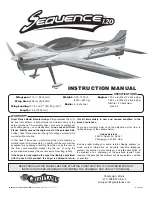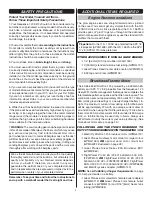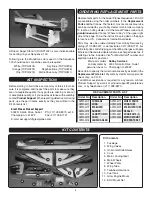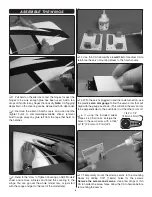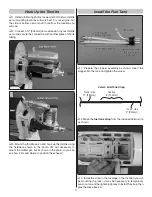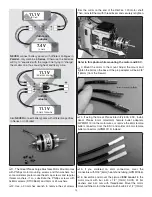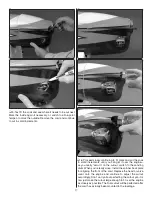
4
❍
Great Planes adhesive-back Velcro (GPMQ4480)
❍
Electrifl y Powermatch Power Meter Balancer (GPMM3220)
IMPORTANT:
Before connecting multiple battery packs with
adapter plugs, refer to the
Battery Precautions
on page 12.
OPTIONAL:
If using the GPMG1260 brushless motor mount for large
motors, it is suggested to replace the Phillips screws and
thin washers that come with the mount with socket-head cap
screws and regular washers (see page 13):
❍
3 x 8mm socket-head cap screws (DTXC8640)
❍
3mm fl at washers (DUBQ3307)
A 2.0mm precision-machined hex driver (DTXR0289) is also
suggested for securely tightening the set screws in the collar
on the shaft of the RimFire 1.20
The preferred propeller for the RimFire 1.20 on 6S is either
the APC 17 x 8E (APCQ4018) or the Xoar 17 x 8 Electric
Series propeller (XOAQ4073).
Note:
The battery wires from the ESC will have to be extended
to reach the battery. See page 14 for more details. Following
are the items that will be required:
❍
2’ Deans 12 gauge silicone wire (WSDC1000)
❍
Deans Ultra Plug
™
set (WSDM3001)
❍
Electrical solder, soldering fl ux, soldering iron
LIPO BATTERY CHARGER REQUIREMENTS
A LiPo-compatible battery charger with cell balancing is required.
When shopping for a charger (if you don’t already have one)
select a charger (and DC power supply if required) capable
of enough power (Watts) to charge your batteries within an
acceptable time—usually one hour. Once you calculate the Watts
required add in a factor of 20% for loss from normal ineffi ciency:
To fi nd out how many Watts are required to charge a 6S,
5,000mAh battery, fi rst multiply the number of cells (6) times
the Voltage of a fully-charged LiPo cell (4.2V):
6 x 4.2V = 25.2V
Then multiply the Voltage of the fully-charged pack by the
pack’s capacity in Amps:
25.2V x 5A = 126 Watts
Finally, increase the Watts needed from a charger by a factor
of 20%:
126 Watts x .2 = 25W + 126W = approximately 150 Watts.
You will need a charger capable of approximately 150 Watts
to charge a 6S 5000mAh battery in about one hour.
If you use two 5000mAh 3S batteries connected in series
with a series adapter you will need a charger capable of
approximately 75 Watts (3 x 4.2 x 5 = 63 + (63 x .2) = 75W).
But then you will have to charge each battery separately
(unless you purchase a charger with multiple charging ports).
If your charger is not capable of the Watts required you should still
be able to charge the battery, except it will take more than one hour.
Radio Equipment
The Sequence can be fl own with as few as four channels, but
the ailerons will have to be connected to the same channel
in the receiver via a dual servo connector (FUTM4130 for
Futaba) and the elevator servos will have to be connected to
the same channel via a servo reverser (FUTM4150). If fl ying
with six channels, the ailerons and elevators can be linked
electronically through the programming in the transmitter to
allow for unlimited mixing/fi ne-tuning options.
Pattern fl yers typically prefer digital servos. Powering the
servos from a 6V receiver battery is also in-line with current
pattern practices, but make certain the servos you chose
are compatible with 6 Volts. Following are the recommended
Futaba servos with the associated servo extensions illustrated
in the manual—if setting up your model differently, different
extensions may be required:
❍
Rudder: S9155 (FUTM0215)
❍
Elevators (2): S9650 (FUTM0260) (2 pcs. 36" [915mm]
servo extension—TACM2726)
❍
Ailerons (2): S9252 (FUTM0222) (4 pcs. 6" [150mm]
servo extension—TACM2701)
❍
Throttle (for glow): S3102 (FUTM0034) (12" [305mm]
servo extension—TACM2711)
❍
HydriMax 1600mAh 6.0V NiMH (HCAM6342) or 2000mAh
6.0V NiMH (HCAM6351) receiver battery
❍
Futaba Switch Harness (FUTM4370)
❍
Great Planes 3"[75mm] double-sided servo arm (for the
rudder servo, GPMM1165)
NOTE:
T h e e l eva t o r
s e r vo s mu s t
m e a s u r e n o
more than 11/16"
[18mm] from
the bottom up
to the mounting
grommets in order to fi t in the horizontal stabilizers. Taller
servos will require shimming to fi t.
ADHESIVES, HARDWARE AND
OTHER ACCESSORIES
Other than common hobby tools here is a list of the rest of
the items required:
❍
1/2 oz. [15g] Thin Pro CA (GPMR6001)
❍
1/2 oz. [15g] Medium Pro CA+ (GPMR6007)
❍
2 oz. [57g] spray CA activator (GPMR6035)
❍
Threadlocker thread locking cement (GPMR6060)
❍
2-1/2" spinner (GPMQ4770)
❍
8mm Propeller Reamer (for O.S. engines or RimFire
1.20 brushless motor) (GPMQ5007)
❍
Drills bits: 1/16" [1.6mm], 3/32" [2.4mm], 1/8" [3.2mm],
7/32" [5.6mm], 7/64" [2.8mm]
11/16"
[18mm]
Summary of Contents for Sequence 1.20
Page 31: ...31 ENGINE CUTOUT TEMPLATE FOR O S 1 55FS a...
Page 32: ......

